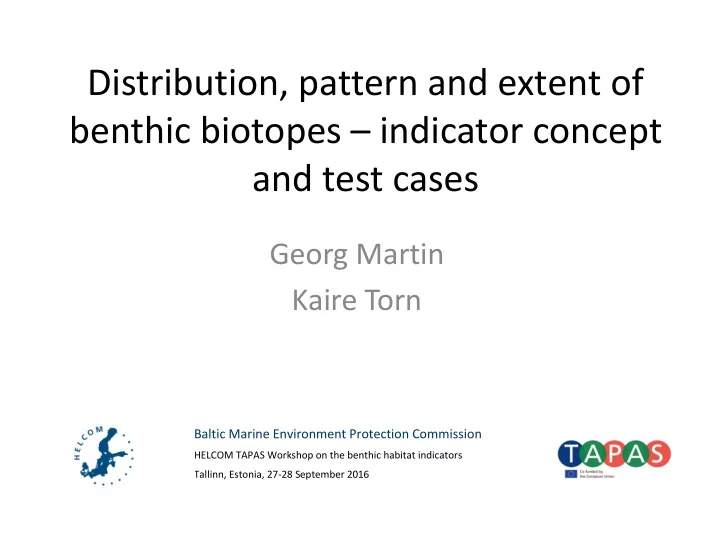

Distribution, pattern and extent of benthic biotopes – indicator concept and test cases Georg Martin Kaire Torn Baltic Marine Environment Protection Commission HELCOM TAPAS Workshop on the benthic habitat indicators Tallinn, Estonia, 27-28 September 2016
Background - MSFD Draft of the Commission Decision laying down criteria and methodological standards on good environmental status of marine waters and specifications and standardised methods for monitoring and assessment, and repealing Decision 2010/477/EU Current version: 4
Background - MSFD D6C4 – Primary: • The extent of loss of the habitat type, resulting from anthropogenic pressures, does not exceed a specified proportion of the natural extent of the habitat type in the assessment area. • Member States shall establish the maximum allowable extent of habitat loss as a proportion of the total natural extent of the habitat type, through cooperation at Union level, taking into account regional or subregional specificities. D6C5 – Primary: • The extent of adverse effects from anthropogenic pressures on the condition of the habitat type, including alteration to its biotic and abiotic structure and its functions (e.g. its typical species composition and their relative abundance, absence of particularly sensitive or fragile species or species providing a key function, size structure of species), does not exceed a specified proportion of the natural extent of the habitat type in the assessment area. • Member States shall establish threshold values for adverse effects on the condition of each habitat type, ensuring compatibility with related values set under other Descriptors…, • Member States shall establish the maximum allowable extent of those adverse effects as a proportion of the total natural extent of the habitat type, through cooperation at Union level, taking into account regional or subregional specificities.
Background – HELCOM HOLAS II
Background – HELCOM HOLAS II
Proposal for assessment scheme Complex index calculated Assessment result is through conditional classified in one of three classification of four status classes (comparable different habitat with three status classes properties: of HD: • Area • GES • Extent (range) • subGES • Quality • nonGES • Impact
Assessed habitat property: Area Defined as the sum of the grid squares where habitat is found at present. Reasonable cell size for the grid should be discussed and agreed. Assessment is based on comparison of current situation with reference level ( e.g. can be level determined during Initial Assessment). Historical data or current data combined with expert judgement may be used to define the reference level.
Assessed habitat property: Extent Defined as area inside the shortest continuous boundary which connects the outer corners of the grids where habitat is found at present. Grids that occur only in the unsuitable areas (e.g. terrestrial areas) will be excluded from the extent. Assessment is based on comparison of current situation with reference level (e.g. can be level determined during Initial Assessment). Historical data or current data combined with expert judgement may be used to define the reference area.
Assessed habitat property: Quality Quality includes the assessment of structure and functions of habitat (e.g. species composition of the benthic community or physical properties reflecting the quality of the habitat e.g. water transparency, presence of oxygen deficiency etc.). Assessment of quality may be based on nationally developed method or on expert judgement. For standardization of the approach it is possible to develop list of meaningful environmental variables/indexes to be used. Proportion of the area or monitored stations in good status defines status class of the habitat quality.
Assessed habitat property: Impact HELCOM pre-core indicator on Cumulative impact on benthic habitats (under development) can be used as fourth component of assessment system.
Overall assessment scheme
Test case – Estonian sea area Area The area of the habitat (HUB level 3, AA.A Baltic photic rock and boulders + AB.A Baltic aphotic rock and boulders) was estimated in 10X10 km cells and compared to area determined in Initial Assessment procedure. No decline in the area was observed so the classification of this property fell into class GES.
Test case – Estonian sea area Extent Extent was estimated according to the rules (10X10 km cells in example, terrestrial cells and areas outside of the Estonian territory with EEZ excluded) and observed extent was compared to one determined in Initial Assessment data. No decline was observed and the classification of this property fell into class GES.
Test case – Estonian sea area Quality Three indicators were used to describe the habitat quality: 1) status of typical species, 2) modelled Secchi depth, 3) oxygen deficiency. Threshold values were taken from existing HD assessment scheme (status of typical species), WFD assessment scheme (Secchi depth) or proposed quality classes. Based on status of the typical species the quality of habitat was GES. Based on Secchi depth and oxygen deficiency, the habitat quality was sub-GES. Lowest quality indicator determines the quality of habitat.
Test case – Estonian sea area
Questions to discuss • Overall approach – has been discussed in IN Benthic network and Skype meeting – acceptance? • Habitat/biotope classification to be used? • Assessment grid size? • Reference level for area/extent? • Quality – defing the list of meaningful metrics? • Availability of data? • Spatial scale of assessment (4 levels)?
Anything else?
Recommend
More recommend